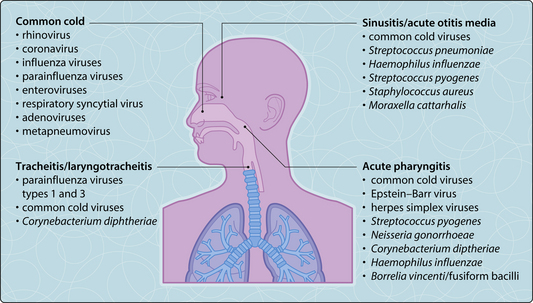13. Upper respiratory tract infections
The upper respiratory tract is the initial site of infection or a site of colonization for most infections of the respiratory tract (Fig. 3.13.1). It is also the site for a number of resident organisms, the prevalence of which will vary in individuals:
 common: Streptococcus mutans and other α-haemolytic streptococci, Neisseria sp., corynebacteria, Bacteroides spp., Veillonella spp., other anaerobic cocci, fusiform bacteria, Candida albicans, Haemophilus influenzae, Entamoeba gingivalis
common: Streptococcus mutans and other α-haemolytic streptococci, Neisseria sp., corynebacteria, Bacteroides spp., Veillonella spp., other anaerobic cocci, fusiform bacteria, Candida albicans, Haemophilus influenzae, Entamoeba gingivalis less common: Streptococcus pyogenes, Streptococcus pneumoniae, Neisseria meningitidis, Staphylococcus aureus.
less common: Streptococcus pyogenes, Streptococcus pneumoniae, Neisseria meningitidis, Staphylococcus aureus.Some of these resident flora can be pathogenic. Infections of the upper respiratory tract (URTIs) are the commonest acute illness. The respiratory tract has defence mechanisms that prevent infection in the normal individual (Fig. 3.13.2). The mucociliary escalator is the process where the mucous lining of the tract is swept upwards by the beating of cilia, thus carrying foreign particles trapped in the mucus up towards the pharynx, where it is swallowed.
< div class='tao-gold-member'>
Only gold members can continue reading. Log In or Register to continue
Stay updated, free articles. Join our Telegram channel

Full access? Get Clinical Tree











